Search Results for 'Eglinton Hotel'
16 results found.
When Salthill was a village
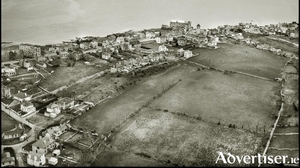
This photograph of Salthill was taken about 75 years ago by Norman Ashe, a Dublin photographer who specialised in aerial photography. Most aerial images of the area were taken from the sea side but he chose the other direction.
The Lazy Wall
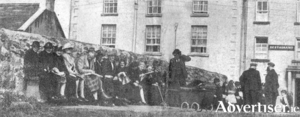
The Lazy Wall was a feature of life in old Salthill. It was situated opposite the Grand Hotel and beside the old RIC barracks. It would be roughly where the west-bound lane opposite where the BonBon is today. It consisted of a long concrete seat, boarded on top, backed by a stone wall. It was not very comfortable but it attracted lots of people, mostly tourists, most of whom were country people.
The Galway and Salthill Tramway Company
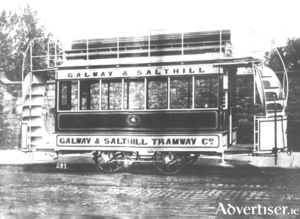
The mid-19th century was an era of little movement of people for social or pleasure purposes. In the post-Famine era, it was only business people of necessity, those who were emigrating or those whose financial circumstances allowed who travelled. Railway travel had come Galway in 1851 and there were a few horse drawn omnibuses operating between the city and the village of Salthill, which was really a rural backwater. But, it was becoming a fashionable place to live and was developing as a tourist destination. It was therefore no surprise when a tramway system between the city and the village was proposed.
The Galway/ Salthill Tramway
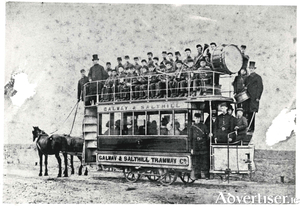
The Galway and Salthill Tramway Company was inaugurated in 1877. The Town Commissioners gave the project every encouragement and extended the time limit in which the tracks had to be laid. The single tramline was two and a quarter miles long with eight passing loops, roughly 250 yards apart. The rails were heavy steel, the gauge was three feet wide and the trams were horse-drawn, there was no electricity in Galway for another 12 years or so. The cost of construction was £13,000. The depot was in Forster Street and the western terminus was opposite the Eglinton Hotel.
Upper Salthill, a bird’s eye view, c1945
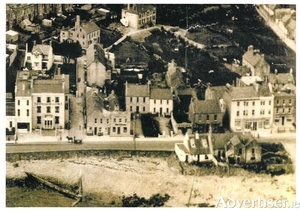
This aerial photograph was taken c1945. On the left you can see the Eglinton Hotel which was originally built in the 1860s. Up to that time, Salthill was a small village that included Lenaboy Avenue and the area between what we know as Seapoint and the Bal. The construction of the Eglinton was on a scale not seen before in Salthill, and it extended the village to the west. It came at a time when locals were beginning to promote the village as a resort, a destination for tourists.
Galway’s first Freeman
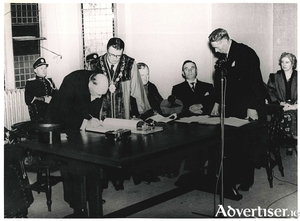
On August 31, 1939, Dr Douglas Hyde, President of Ireland, signed his name in Irish in a small leather-bound book as the first Freeman of Galway.
The end of the line
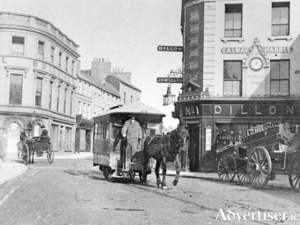
Fifteen years before the Galway-Clifden railway started, the first light-rail track laid in Galway was the tram service to Salthill. For more than 39 years a series of horse-drawn trams ran from the depot in Forster Street, along the east and south sides of Eyre Square, heading west through Shop Street and Dominick Street, over the bridge, and along the Salthill road. Then it was in the countryside with open fields and thatched cottages. The line came to an end at the Eglinton Hotel (now a hostel), where the horse was switched to the other end of the tram for the return journey. The Eglinton became Europe’s most westerly tram terminus.
The Rockland Hotel
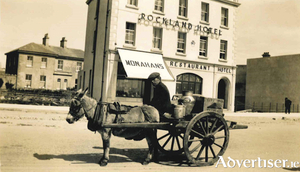
In 1923 Forster Park, the residence of Gerald Cloherty, clerk of the crown and peace for County Galway, sold his house to surgeon Michael O’Malley. In July 1935 the Connacht Tribune reported that the purchase of plots in front of the house recently occupied by Dr O’Malley, and the question of allowing the purchasers to proceed with the building immediately, or to force them to defer until the road along the Promenade had been widened, was the subject of a long discussion at the Urban District Council meeting.
Moon’s
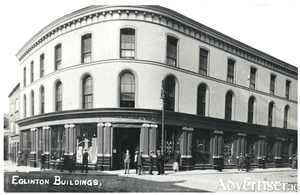
This building was designed by a Mr Farquarson around the year 1812. It has a three storey façade. The bays on the ground floor are articulated by paired fluted ionic pilasters while on the first floor, there are round-headed windows with moulded architraves which are flush with the wall surface and on the second floor segmented–headed windows similarly treated. The exterior has been preserved unchanged since it was built and is one of the most attractive corners in Galway, complemented by the rounded corner of what used to be McNamara’s and the elegant corner of what used to be Dillon’s.
Direct Provision: Time To Go

At this stage most of us are familiar with the national failure that is Direct Provision; the State's accommodation for asylum seekers set up in 1999 as a temporary measure which is now nearly as old as I am.

